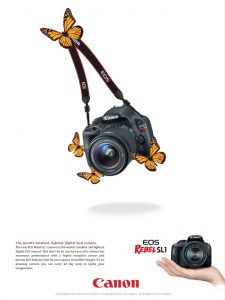The Original Cam
 The picture above is an advertisement for the ever-popular Canon camera. In photography, this brand is one of the most popularly used among professional photographers because of the quality of pictures it produces and the ease at which this can be done.
The picture above is an advertisement for the ever-popular Canon camera. In photography, this brand is one of the most popularly used among professional photographers because of the quality of pictures it produces and the ease at which this can be done.
The marketing gimmick in this ad is how lightweight and small the DSLR camera is but still performs optimally. In this world where everything is so fast paced, efficient products that do not take on much space, sell very well. Its lightweight features are further emphasized through the butterflies’ ability to lift the camera. Aside from butterflies being light thereby accentuating this unique feature of this handheld device, they are also further used as a prop to enhance the beauty of the product; nature as a backdrop for these devices to be important.
Furthermore, the hand at the corner of the page also re-emphasizes the camera’s portability that “it is so small it can fit into your palm”. The feminine hands, colorful butterflies and the calm white background makes the ad easy on the eye and makes it easily likeable.
One can easily argue that the target audience is general, and this ad can be designed for people who are constantly on the move but want to capture moments. These criteria can fit anyone in this day and age from bloggers, to nature lovers, to foodies to professional photographers.
Its lightweight and portable capacity is nonetheless due to some of the ‘efficient’ components that are in the construction of this camera. One main example is the lithium ion batteries which they boast of as “weight saving, without any associated loss of power”1. These lithium batteries often originate from problematic circumstances i.e. conflict stricken nations such as the Democratic Republic of Congo. The failure to highlight the possible problematic origins of some of these essential components will be addressed in my rendition of this ad. The fact that an ethic/cruelty-free disclaimer was not set can leave room for this argument to expand further.
The Jammed Cam

In this ad, there are red highlights on the formerly white background and a black woman bent down with the illusion of the camera on her back. These red smudges symbolize the blood and suffering that is put into the production of these products we use. Some of the little essential units that are used in the manufacturing of everyday gadgets-phones, cameras, electric cars, jewelry, are often to the detriment of certain persons. This is not to say these people, do not have agency to refuse to partake in such labor, but the way the neoliberal world is set up, people with very little power and economic capital have less options. The imagery of the woman bent down paints the idea of how these products are often done on the backs of marginalized bodies such as hers. She was also deliberately faded to symbolize how invisible their struggles and stories are in the sale and manufacturing of these products. The butterflies are carrying this camera because of its perceived lightness but in actuality it is because of the labor of people like this woman.
The Democratic Republic of Congo produces over 60% of the world’s supply of cobalt which is an essential element in lithium ion batteries2. The conditions under which this product is mined is not safe and there are no proper regulations to make sure children are protected and prevented from working in such environments. People are exposed to lethal mineral dust and use contaminated water that has been tainted by industrial debris from the “artisanal” mining. After such exposure, these workers are often compensated with about $0.65 or if they are lucky, $1.80 for an entire day’s work3. These mined materials are then smuggled by Chinese buying houses to other countries for processing and then sold to other countries for manufacturing purposes. The ethics of this industry is almost nonexistent as some companies have superficially expressed their disapproval for exploitation and child labor but for the most part, it ends there as this is yet another cheap way to ensure a lowered cost of production.
Bibliography
1Canon Europa N.V., and Canon Europe Ltd. “Battery Types.” Canon Professional Network. https://cpn.canon-europe.com/content/education/infobank/batteries/battery_types.do.
2Kara, Siddharth. “Is Your Phone Tainted by the Misery of 35,000 Children in Congo’s Mines? | Siddharth Kara.” The Guardian. October 12, 2018. https://www.theguardian.com/global-development/2018/oct/12/phone-misery-children-congo-cobalt-mines-drc.
3Kara, Siddharth. “Is Your Phone Tainted by the Misery of 35,000 Children in Congo’s Mines? | Siddharth Kara.” The Guardian. October 12, 2018. https://www.theguardian.com/global-development/2018/oct/12/phone-misery-children-congo-cobalt-mines-drc.
